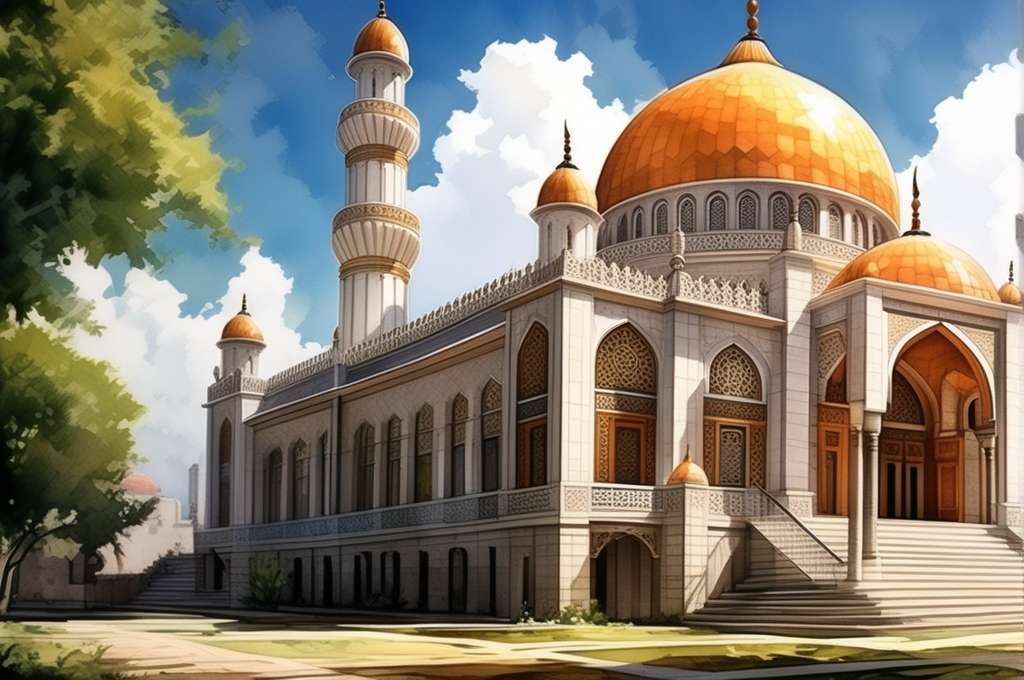10 Spiritual & Biblical Meanings of Ancient Landmarks

Have you ever wondered about the spiritual and biblical significance of ancient landmarks? From the pyramids of Egypt to Stonehenge in England, these enigmatic structures have captivated human imagination for centuries.
In this blog, we’ll explore the profound meanings and symbolisms behind 10 of the most iconic ancient landmarks, shedding light on their spiritual and biblical relevance.
Whispering the wisdom of ancestors, ancient landmarks guide our hearts. They stand as testaments to faith, etched in stone and time. Within their weathered forms, echoes of resilience resonate, urging us to leap beyond limitations and embrace transformation.
What is the meaning of ancient landmarks?

The meaning of ancient landmarks extends far beyond just marking physical boundaries. These weathered markers stand as whispers from the past, each one a silent storyteller weaving tales of history, culture, and the human spirit. Their significance can be unpacked in various layers:
1. Boundaries and belonging:
In the most literal sense, ancient landmarks established borders, defining territories and ownership. They ensured stability and facilitated trade, forming a foundation for early societies. Moving or tampering with these markers was often considered a grave offense, highlighting their crucial role in maintaining order and a sense of belonging.
2. Echoes of history:
Beyond mere boundaries, these landmarks act as portals to the past. Each stone, every inscription, every intricate carving speaks of the lives lived, the battles fought, and the triumphs celebrated in their shadow. They offer glimmers into ancient ways of life, allowing us to connect with generations who walked the same earth before us.
Symbols of continuity and resilience: Standing stoic over time, weathering storms, and the ravages of nature, ancient landmarks embody resilience. They remind us that despite the ever-changing tides of history, some things endure, whispering tales of perseverance and the enduring human spirit.
3. Inspiration and guidance:
Ancient landmarks aren’t merely relics of the past; they offer valuable lessons for the present. Observing their construction, their placement, and their enduring legacy, we can glean insights into past societies’ values, ingenuity, and relationship with the land. These lessons can inspire us to build structures with a long-term vision, fostering a sense of connection to the past and guiding our choices for the future.
Likewise, the meaning of ancient landmarks lies in their ability to bridge the gap between past, present, and future. They serve as tangible anchors, reminding us of our roots, prompting us to learn from history, and inspiring us to build a future with respect for the legacy we inherit.
Spiritual meanings of the ancient landmark

1) Connection to the divine:
Ancient landmarks like temples, shrines, and sacred sites were considered places where humans could connect with the divine realm. People would visit these sites to foster personal growth through spiritual rituals, prayer, meditation, and contemplation. They represented a bridge between the mundane world and the transcendent realm of the gods or God.
2) Representation of God’s principles:
In many ancient societies, landmarks embodied the religious and moral principles of that culture. Structures like the Temple in Jerusalem or the Kaaba in Mecca were tangible symbols of a people’s spiritual beliefs and values. Preserving these sites kept the memory of God’s laws and traditions alive.
3) Protection of the vulnerable:
Ancient laws often prohibited tampering with landmarks and property boundaries to protect vulnerable groups like widows, orphans, and the poor from exploitation. Moving a landmark could deprive them of their rightful inheritance and livelihood. Upholding these boundaries ensured social justice.
4) Safeguarding national integrity:
Maintaining the same ancient boundaries, laws, and customs preserved the integrity and stability of the nation. Alterations could undermine the spiritual heritage of a society and introduce corruption or injustice. Honoring age-old traditions was tied to social cohesion.
5) Warning against theft:
The Bible warns against moving boundary stones, equating this act with theft, encroachment, and taking advantage of those who cannot defend themselves. This injunction promoted honesty, fairness, and concern for the vulnerable.
6) Significance in religious traditions:
Landmarks like the Western Wall in Jerusalem or the Ganges River in India are central to religious ceremonies and rituals. They maintain a connection to the shared history and beliefs that shape a faith tradition.
7) Intersection of cultures:
Ancient sites often blended the architectural and artistic traditions of different civilizations. This allowed for cultural exchange and learning across spiritual boundaries.
8) Guidance for living:
The principles embedded in ancient landmarks provided a model for righteous, ethical living. Their endurance reflected the timeless wisdom they imparted.
9) Appreciation of history:
Visiting ancient spiritual sites allows people to reflect on the passage of time, appreciate cultural heritage, and contemplate the beliefs that shaped societies across generations. This fosters self-awareness and connection to the past.
10) Symbol of Stability and Continuity:
Ancient landmarks represent stability and continuity because their enduring physical presence symbolizes the permanence of God’s promises and purposes. Sites like the Western Wall and Mount Sinai have spiritual significance due to their connection to definitive divine events.
Despite the destruction of human-made monuments, these landmarks persist as tangible reminders of God’s eternal covenants and unchanging principles. Their longevity inspires confidence in God’s unwavering presence and emphasizes the need to maintain the boundaries God has instituted.
Ancient landmarks stand as symbolic testaments to the continuity of the divine amidst the impermanence of human societies.
10 most important ancient landmarks spiritually

| Sacred Place | Spiritual Meaning |
|---|---|
| Mecca, Saudi Arabia | The holiest city in Islam, the birthplace of Prophet Muhammad; pilgrimage site, symbolizing unity and submission to God. |
| Pashupatinath Temple, Nepal | The sacred Hindu temple complex; represents cycles of life, death, and rebirth; and honors Lord Shiva, the lord of creation. |
| Jerusalem, Israel | Holy city in Judaism, Christianity, and Islam; represents divine connection, religious history, and redemption. |
| Lourdes, France | Site of Marian apparitions, pilgrimage destination; known for healing, miracles, and spiritual purification. |
| Kapilavastu, Nepal | Birthplace of Buddha; signifies the origin of Buddhism, spiritual enlightenment, and the path to inner awakening. |
| Mount Kailash, Tibet | Sacred in Hinduism, Buddhism, and Jainism; symbolizes divinity, enlightenment, and the center of the spiritual universe. |
| Uluru (Ayers Rock), Australia | Sacred to Indigenous Australians; embodies creation, ancestral spirits, and ongoing spiritual significance. |
| Delphi, Greece | Ancient religious sanctuary; associated with Apollo, wisdom, prophecy, and seeking spiritual guidance. |
| Machu Picchu, Peru | Incan citadel, a spiritual center; represents a connection with nature, cosmic energy, and ancient spirituality. |
| Pyramid of Egypt | Represents ancient Egyptian beliefs in the afterlife, divine power, and the pharaoh’s ascent to the heavens. |
| Stonehenge, United Kingdom | Ancient stone circle; believed to have astronomical and spiritual significance, associated with rituals and cycles. |
Ancient landmark meaning in the Bible

In the Bible, ancient landmarks represent both physical demarcations of property boundaries as well as metaphorical moral and spiritual boundaries instituted by God. Respecting landmarks is presented as a vital obligation.
Physical landmarks like stone pillars or heaps of stones marked boundaries between different Israelite tribes or families as described in Deuteronomy 19:14 and Proverbs 22:28 – “Do not move an ancient landmark or enter the fields of the fatherless.” Moving these meticulously established boundaries was considered deception and stealing, similar to moving a neighbor’s property line.
The Bible strongly condemns this, equating it with the exploitation of the vulnerable like widows and orphans who would lose their land. Job 24:2 states “Men move boundary stones; they pasture flocks they have stolen.” Hosea 5:10 declares “Judah’s leaders are like those who move boundary stones.” This injunction protected inheritance rights.
Metaphorically, landmarks also refer to God’s moral laws, boundaries, and behavioral codes. Deuteronomy 27:17 states “Cursed is anyone who moves their neighbor’s boundary stone.” This applied to spiritual landmarks like the Ten Commandments which were immutable moral boundaries.
Proverbs 23:10 warns “Do not move an ancient boundary stone or encroach on the fields of the fatherless.” This implied respecting God’s ethical principles which safeguarded the vulnerable. Sin was viewed as crossing God’s landmarks.
Overall, ancient landmarks represented respect for divinely inspired limits on behavior and integrity in conduct. Their permanence reflected the permanence of God’s righteousness and wisdom for ordering human societies. Moving them was a profound act of deception and injustice.
Do not remove the ancient landmarks meaning in the Bible

1) It refers to physical boundary markers between lands and property.
Deuteronomy 19:14 – “Do not move your neighbor’s boundary stone set up by your predecessors in the inheritance you receive in the land the Lord your God is giving you to possess.”
2) Moving landmark stones was equated with theft and taking advantage of those who could not defend themselves.
Proverbs 22:28 – “Do not move an ancient boundary stone set up by your ancestors.”
Hosea 5:10 – “Judah’s leaders are like those who move boundary stones.”
3) It could deprive orphans and widows of their inheritance and livelihood.
Proverbs 23:10 – “Do not move an ancient boundary stone or encroach on the fields of the fatherless.”
4) Leaving landmarks undisturbed maintained justice and protected rights.
Deuteronomy 27:17 – “Cursed is anyone who moves their neighbor’s boundary stone.”
5) Spiritually, it refers to upholding God’s moral boundaries and laws.
Proverbs 22:28 – “Do not move an ancient boundary stone set up by your ancestors.”
6) Crossing God’s boundaries was viewed as sin and rebellion.
Jeremiah 5:22 – “Your wickedness will punish you; your backsliding will rebuke you. Consider then and realize how evil and bitter it is for you when you forsake the Lord your God and have no awe of me,’ declares the Lord, the Lord Almighty.”
7) Ancient landmarks represented respect for tradition, integrity, and God’s wisdom.
Proverbs 22:28 – “Remove not the ancient landmark, which thy fathers have set.”
In summary, the injunction against removing ancient landmarks emphasized upholding both physical property boundaries as well as God’s moral and spiritual boundaries. This demonstrated respect for what God and ancestors had righteously established.
Spiritual interpretations of dreams about ancient landmarks

Ancient landmarks in dreams often symbolize our inner spiritual compass. The condition of the landmark indicates the state of your soul landscape – its stability, integrity, and steadfastness.
1. Dreaming about an ancient landmark like a pyramid, temple, or stone monument can represent your connection to long-lasting traditions, principles, or foundations in your life. It may symbolize values that provide stability or meaning.
2. An ancient landmark could represent something enduring that grounds you, like religious faith, moral code, or family bonds. It reflects principles that have guided you and provided direction.
3. If the landmark is damaged or crumbling, it may indicate feeling spiritually lost or insecure, like your values or belief system is compromised. You may need to renew your commitment to what really matters.
4. Discovering or uncovering an ancient site may reflect a desire to explore your roots and spiritual heritage. This dream can signify a need to uncover meaning or realign with your core values.
5. Being unable to access or find your way to a landmark may reflect confusion about your direction. You may need to get back in touch with what guides you.
6. Restoring or repairing an ancient site suggests a period of rebuilding spiritual foundations or reconnecting to wisdom that has endured over time. Returning to roots.
7. Letting go of an old landmark points to leaving behind limiting beliefs, and outdated perspectives or starting fresh spiritually. Making space for new growth.
Final words

In conclusion, ancient landmarks hold profound spiritual and biblical meanings. They symbolize critical spiritual boundaries that should not be moved or broken, representing God’s principles, customs, and the enduring nature of His promises.
The Bible emphasizes the importance of not changing these ancient landmarks, as they embody God’s timeless truth and standards, and serve as a connection between the mundane world and the divine.
Visiting these landmarks can be a transformative experience, connecting individuals to their inner selves and the ancient wisdom that resides within these sites.
Therefore, ancient landmarks continue to play a vital role in spiritual journeys, providing a space for meditative practices that foster personal growth and spiritual exploration.
You Might Also Like
1) Spiritual & Biblical Meaning of a Double-Yolk Egg (2 Yolks)
2) Left Eye Twitching Biblical Meaning for Females & Males
3) Why Do I Wake Up At 2 AM? Spiritual & Biblical Meaning
4) 7 Spiritual Meanings of Waking Up at 3am: Biblical





